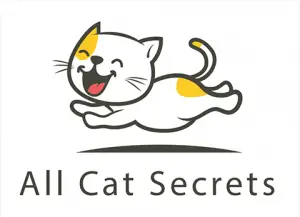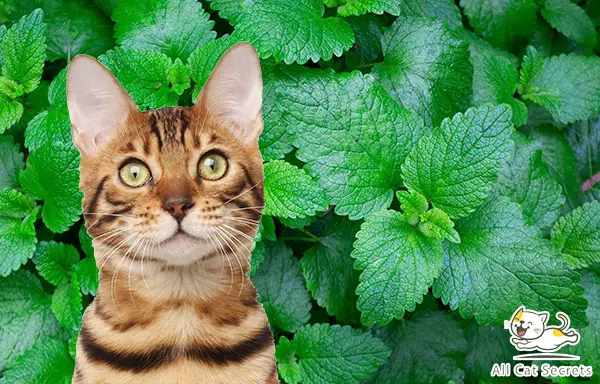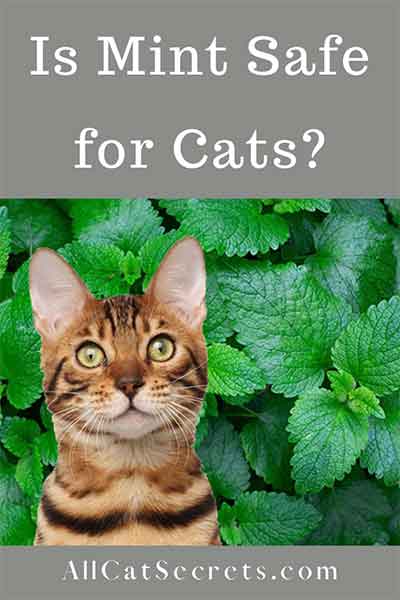Cats are obligate carnivores, which implies that they can survive exclusively on a diet of animal protein. However, that doesn’t stop you from supplementing your kitto’s dietary needs with plant matter.
Indeed, if you’ve owned a cat for a fairly long duration, you must have realized that your feline friend often snacks on grass blades in your backyard.
Like most carnivorous animals, plant matter helps to relieve stomach upset and several other gastrointestinal complications.
However, when it comes to offering plant matter to your cats, there are always exceptions. For instance, you could be wondering, can cats have mint?
Maybe, the question we should be settling is not whether your feline friend can have mint but if the herb is safe for your cat in the first place. So, is mint safe for cats?
The answer is no, mint is not safe for cats. Mint leaves, flowers, stems, and the entire plant is laden with essential oils that are considered highly toxic to cats. So, not only should cats avoid the mint plant, but also every mint-based product.
Read on as we dissent the topic further and unpack everything there is to know about cats and mint.
Table of Contents
Is Mint Good For Cats? A Look Into What Mint Is
Having already pointed out that cats should not have mint, your next concern might be, is mint safe around cats?
Well, the safety of mint around cats shall become abundantly clear as you read on.
But first, let’s learn more about the mint plant so that you can have a better idea of what it is all about. You never know – the plant might be thriving in your backyard and your cat could be nibbling on its leaves without your knowledge.
Now, mint isn’t technically a plant by itself. Instead, it’s a genus name that comprises certain plants in the Lamiaceae family.
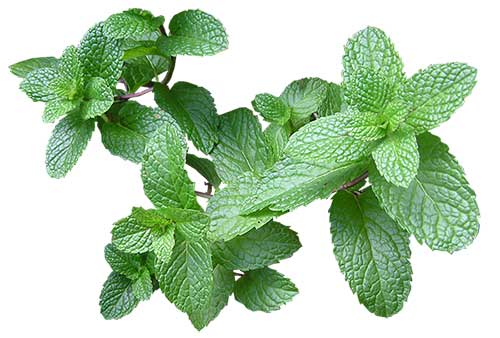
Also known as Mentha, plants in the mint family are mostly used as condiments as well as in folk medicine, cosmetics, and aromatherapy. Some of these plants are also used to make insecticides and modern pharmaceutical drugs. Mint comes in various species as well as hybrids.
Examples of mint species include;
- Slender mint;
- Water (mash mint);
- Sweet mint;
- Wild mint;
- Banana (field) mint, also known as the Japanese peppermint;
- Corn mint;
- Corsican mint;
- American wild, also known as Australian mint;
- Horsemint;
- Spearmint;
- Pineapple (apple) mint;
- Catnip/Catmint;
- Pennyroyals, etc.
Examples of mint hybrids include;
- Chocolate mint;
- Ginger mint;
- False apple mint;
- Red raripila mint;
- Large apple mint; and
- Sharp-toothed mint.
Though mint comprises of different species and hybrids, most of these plants pack the same compounds and cats react to them in a near-similar manner.
For instance, most mints exude a pleasant perfume, which is known to wow cats. And that may have you wondering, is mint ok for cats?
The fact that mint produces a savory smell doesn’t make the plant safe for your feline friend. And the next sections shall shed more light on that.
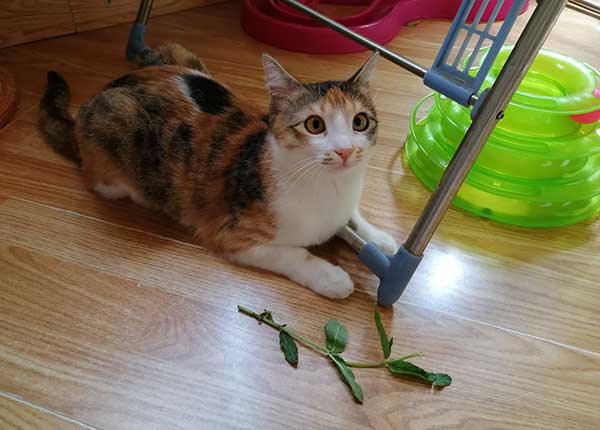
Are Cats Attracted To Mint?
Mint may be considered unsafe for cats. But for some reason, cats are attracted to the plant. But just why do cats love mint, and why is my cat obsessed with mint?
As we’ve already highlighted, the primary reason why your cat loves mint is the pleasant aroma that the mint plant produces. The smell is attributed to the presence of a chemical known as nepetalactone, which closely resembles a cat’s pheromones.
Out of the numerous mint species out there, the following are the three main variants of the plant that cats are particularly interested in.
1. Catnip
Catnip goes by numerous names, ranging from catmint, catswort, catwort, etc.
Catnip is the variant of mint plants that most cats are attracted to. And there are plenty of reasons for that. But the main reasons are the attractive smell that the plant produces and the stimulating effects it has on cats.
The pleasant aroma and stimulating effects are attributed to nepetalactone, which is the active ingredient in catnip (and all other mints).
By imitating your cat’s natural sex pheromones, nepetalactone induces a mild euphoria. When your cat is in a state of euphoria, it feels energized and refreshed. As a result, the cat will tend to enjoy the activities that naturally make it happy, such as playing, eating, and having sex.
So, nepetalactone can also be considered a mild feline aphrodisiac, which explains why some male cats often nibble on mint leaves when the females are on heat.
Evidently, the mild euphoria and pleasant aroma that your cat gets from nibbling on catnip appear to be beneficial for the cat. So, you may be wondering, is mint plant poisonous to cats or can I allow my cat to freely hang around catnip?
Well, as far as the American Society for the Prevention of Cruelty to Animals (ASPCA) is concerned, catnip remains a potentially harmful herb for your kitto, its benefits notwithstanding.
- ???????????? ???????????????? ????????????????????????????: because you’ll have a ring-side seat to the greatest show on earth....
- ???????????????? ???????????????????? ????????????'???? ????????????????????????????????????: since Cat Crack’s Cat Nip Organic...
- ????????'???????? ???????????? ???????????? ???????????????? ????????????????????: with a 78%+ Nepetalactone content. It’s the...
Last update on 2025-04-12 / Affiliate links / Images from Amazon Product Advertising API
2. Peppermint
Generally, cats aren’t attracted to peppermint the way they are to catnip. While peppermint exudes a pleasant minty fragrance, cats are repulsed by that smell.
Also, peppermint contains a chemical known as salicylate, which is considered harmful for cats. Your cat may not understand how poisonous salicylate is until it has nibbled on peppermint leaves.
However, it’s worth noting that not all cats are repulsed by peppermint. As peppermint also contains compounds similar to nepetalactone, your cat may be attracted to the plant. Just ensure that your cat doesn’t eat peppermint leaves.
3. Spearmint
Spearmint is mostly available as tea, as well as in candy and seasoning. It contains lower levels of salicylate compared to peppermint.
So, in terms of toxicity, spearmint is less toxic compared to peppermint. But as with any other mint, you should ensure your feline friend doesn’t eat any spearmint.
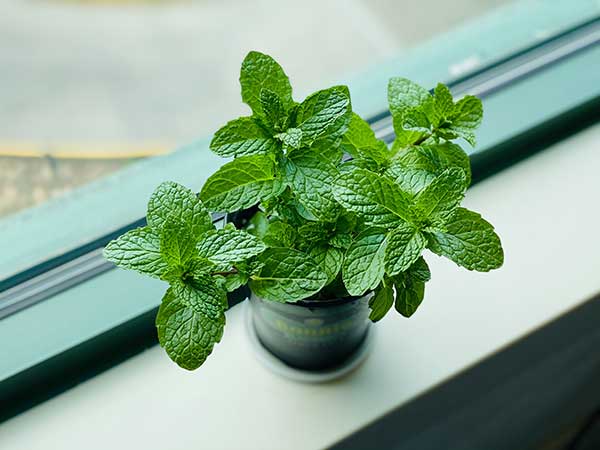
Is Mint Bad For Cats? A Review of What Could Go Wrong
Is mint toxic to cats?
Though we’ve already mentioned it, it warrants repeating that yes, mint is toxic to cats. There are numerous things that could go wrong if your cat eats mint.
Most notably, being a plant matter, mint might irritate your cat’s digestive system, leading to gastrointestinal complications.
Secondly, depending on the part of the plant that the cat has eaten, there could be risks of choking.
And that brings us to the question, which parts of the mint plant present higher toxicity? Let’s find out by answering a series of questions.
Can cats eat fresh mint leaves?
Are mint leaves safe for cats?
This is one of the most common questions among pet owners who are considering incorporating mint into their cats health and wellness routine. But, can cats eat mint leaves?
No, cats can’t and shouldn’t eat mint leaves.
As we already highlighted, mint leaves contain essential oils that could make your cat terribly ill. Fresh leaves may contain lower levels of mint essential oil compared to other parts of the plant. But it’s still high enough to make your cat sick.
Is mint oil safe for cats?
Besides mint leaves, there’s also the question of mint oil for cats. And you could be wondering, is mint oil bad for cats?
Yes, it is. Most of the harmful chemicals in mint are more abundant in mint oil, which is why experts discourage mint oil for cats.
In a nutshell, eating mint in whatever form can expose your cat to mint poisoning. The condition manifests in;
- Gastrointestinal complications, such as diarrhea, upset stomach, constipation, and abdominal pain;
- Lethargy;
- Elevated heart rate;
- Seizures;
- And skin irritation (if the cat comes into physical contact with the plant).
The severity of mint poisoning depends on factors like the quantity of mint the cat has eaten, the variant of the plant, and the general immunity of the cat.
Certain variants of mint, such as pennyroyal, are known to cause severe cases of mint poisoning, which might escalate into liver failure.
Also, cats with pre-existing medical conditions, such as liver disease, heart disease, and bowel disease, are likely to develop more severe forms of mint poisoning.
- High protein cat food dry formula with real chicken as the first ingredient
- Natural with prebiotic fiber nourishes specific intestinal bacteria for digestive health
- Wholesome cat food dry kibble with vitamin A and Omega-6 fatty acids to nourish skin and coat
Last update on 2025-04-13 / Affiliate links / Images from Amazon Product Advertising API
Is Mint Extract Safe For Cats?
So far, the verdict is that cats should not eat mint in all conceivable forms. So, that only means that even mint extracts are harmful for cats.
Mint extracts come in various shapes and forms, and it’s not just the mint in them that makes them poisonous for cats.
Let’s review some of these extracts by answering a few related questions.
Can cats eat mint candy?
Mint candy contains traces of mint essential oil, which is considered poisonous for cats. Plus, mint candies are also laden with artificial sweeteners, all of which are toxic for cats. So, can cats eat polo mints? What about sweet mints, can cats eat sweet mint?
Well, a mint candy by any other name is just as toxic for cats. And that also includes the lime juice-flavored, white rum-enriched mojito mint. If you were also wondering, is mojito mint safe for cats, the answer remains a resounding no.
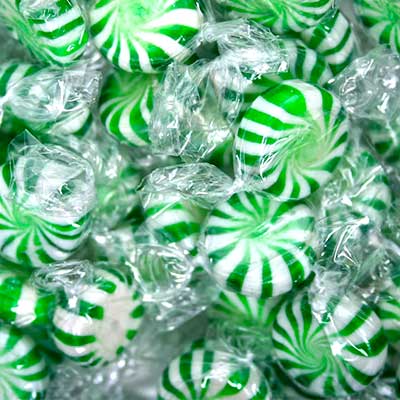
But why do cats like mint gum?
That has a lot to do with the scintillating aroma of mint gum which smells the same as nepetalactone found in the wild mint.
And that brings us to two similar questions – is wild mint safe for cats, and can cats eat mint herb? And the answer is still a no.
Is mint tea bad for cats?
Again, cats should not have mint tea for the simple reason that the tea contains the toxic compounds present in mint.
Is chocolate mint safe for cats?
Chocolate popularly ranks among the top human foods that experts discourage for pets. And combined with the toxic compounds in mint, it goes that chocolate mint isn’t safe for cats either.
Can cats eat mint ice cream?
Like mint chocolate, mint ice cream also contains too many artificial sweeteners and other ingredients that make it unsafe for cats.
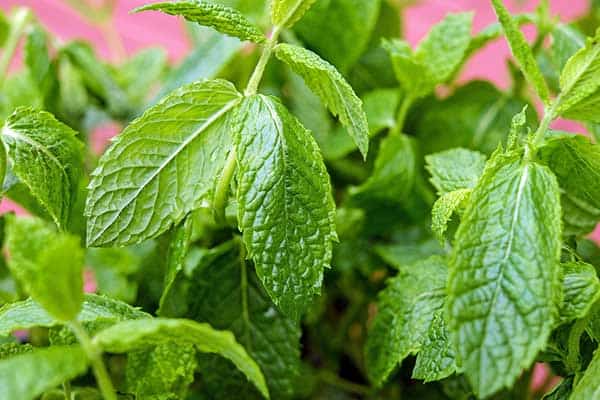
Conclusion: Can Cats Eat Mint?
Mint herb is toxic for cats in all its conceivable forms. So, you could be wondering, how can cats enjoy mint safely?
Well, considering its toxicity, there’s no such thing as a safe way for cats to enjoy mint. Your best bet is to keep the plant as far away from your feline friend as possible.
Checkout Our Favorite Cat Products
1. Best Online Course For Cat Parents
Our favorite: The Cat Language Bible (How to Finally Understand And Speak to Your Cat) – A new form of cat to human communication that many cat owners have dreamed about… but few have actually thought possible.
2. Best Immune Support For Cats
Our favorite: Tomlyn Immune Support – Best Supplement for Cats and Kittens.
3. Best Cat Treats
Our favorites: LIFE ESSENTIALS All Natural Freeze Dried Chicken And Sheba Meaty Tender Sticks – Both are Great.
